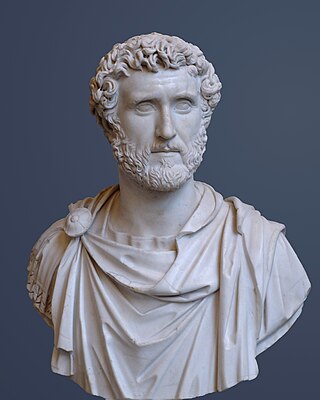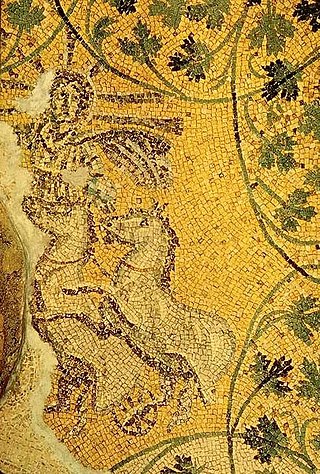Related Research Articles

Titus Aelius Hadrianus Antoninus Pius was Roman emperor from 138 to 161. He was the fourth of the Five Good Emperors from the Nerva–Antonine dynasty.

Hadrian was Roman emperor from 117 to 138. He was born in Italica, close to modern Seville in Spain, a small Roman municipium of Hispania Baetica founded by Scipio as an Italic settlement; his branch of the Aelia gens, the Aeli Hadriani, came from the town of Hadria. Hadrian was a member of the Nerva–Antonine dynasty.

Marcus Aurelius Antoninus was Roman emperor from 161 to 180 AD and a Stoic philosopher. He was a member of the Nerva–Antonine dynasty, the last of the rulers later known as the Five Good Emperors and the last emperor of the Pax Romana, an age of relative peace, calm, and stability for the Roman Empire lasting from 27 BC to 180 AD. He served as Roman consul in 140, 145, and 161.
The 130s decade ran from January 1, 130, to December 31, 139.

Antinous, also called Antinoös, was a Greek youth from Bithynia and a favourite and lover of the Roman emperor Hadrian. Following his premature death before his twentieth birthday, Antinous was deified on Hadrian's orders, being worshipped in both the Greek East and Latin West, sometimes as a god and sometimes merely as a hero.

Cyzicus was an ancient Greek town in Mysia in Anatolia in the current Balıkesir Province of Turkey. It was located on the shoreward side of the present Kapıdağ Peninsula, a tombolo which is said to have originally been an island in the Sea of Marmara only to be connected to the mainland in historic times either by artificial means or an earthquake.

Lucius Aurelius Verus was Roman emperor from 161 until his death in 169, alongside his adoptive brother Marcus Aurelius. He was a member of the Nerva-Antonine dynasty. Verus' succession together with Marcus Aurelius marked the first time that the Roman Empire was ruled by more than one emperor simultaneously, an increasingly common occurrence in the later history of the Empire.

The Pantheon is a former Roman temple and, since 609 AD, a Catholic church in Rome, Italy, on the site of an earlier temple commissioned by Marcus Agrippa during the reign of Augustus. It was rebuilt by the emperor Hadrian and probably dedicated c. 126 AD. Its date of construction is uncertain, because Hadrian chose not to inscribe the new temple but rather to retain the inscription of Agrippa's older temple, which had burned down.

Egypt was a subdivision of the Roman Empire from Rome's invasion of the Ptolemaic Egyptian Kingdom after the battle of Alexandria in 30 BC to its loss by the Byzantine Empire to the Islamic conquests in AD 641. The province encompassed most of modern-day Egypt except for the Sinai, and was bordered by the provinces of Crete and Cyrenaica to the west and Judaea, later Arabia Petraea, to the East. Egypt came to serve as a major producer of grain for the empire and had a highly developed urban economy. Aegyptus was by far the wealthiest Eastern Roman province, and by far the wealthiest Roman province outside of Italy. The population of Roman Egypt is unknown, although estimates vary from 4 to 8 million. Alexandria, its capital, was the largest port and second largest city of the Roman Empire.

Annia Galeria Faustina the Elder, sometimes referred to as Faustina I or Faustina Major, was a Roman empress and wife of the Roman emperor Antoninus Pius. The emperor Marcus Aurelius was her nephew and later became her adopted son, along with Emperor Lucius Verus. She died early in the principate of Antoninus Pius, but continued to be prominently commemorated as a diva, posthumously playing a prominent symbolic role during his reign.

Annia Galeria Faustina the Younger was Roman empress from 161 to her death as the wife of Emperor Marcus Aurelius, her maternal cousin. Faustina was the youngest child of Emperor Antoninus Pius and Empress Faustina the Elder. She was held in high esteem by soldiers and her husband as Augusta and Mater Castrorum and was given divine honours after her death.

The art of Ancient Rome, and the territories of its Republic and later Empire, includes architecture, painting, sculpture and mosaic work. Luxury objects in metal-work, gem engraving, ivory carvings, and glass are sometimes considered to be minor forms of Roman art, although they were not considered as such at the time. Sculpture was perhaps considered as the highest form of art by Romans, but figure painting was also highly regarded. A very large body of sculpture has survived from about the 1st century BC onward, though very little from before, but very little painting remains, and probably nothing that a contemporary would have considered to be of the highest quality.

The study of Roman sculpture is complicated by its relation to Greek sculpture. Many examples of even the most famous Greek sculptures, such as the Apollo Belvedere and Barberini Faun, are known only from Roman Imperial or Hellenistic "copies". At one time, this imitation was taken by art historians as indicating a narrowness of the Roman artistic imagination, but, in the late 20th century, Roman art began to be reevaluated on its own terms: some impressions of the nature of Greek sculpture may in fact be based on Roman artistry.

The Temple of Hadrian is an ancient Roman structure on the Campus Martius in Rome, Italy, dedicated to the deified emperor Hadrian by his adoptive son and successor Antoninus Pius in 145 CE This temple was previously known as the Basilica of Neptune but has since been properly attributed as the Temple of Hadrian completed under Antoninus Pius. With one cella wall and eleven columns from the external colonnade surviving, the remains of the temple have been incorporated into a later building in the Piazza di Pietra, whereby its facade, alongside the architrave which was reconstructed later on, was incorporated into a 17th-century papal palace by Carlo Fontana, now occupied by Rome's Chamber of commerce. While only part of the structure remains, excavations and scholarship have provided us with information regarding its construction techniques and stylistic influences, helping us recreate the building dynamics and significance of the Temple of Hadrian in Imperial Rome.

Appia Annia Regilla, full name Appia Annia Regilla Atilia Caucidia Tertulla, was a wealthy, aristocratic and influential Roman woman, who was a distant relative of several Roman emperors and empresses. She was the wife of the prominent Greek Herodes Atticus.
The gens Aelia, occasionally written Ailia, was a plebeian family in Rome, which flourished from the fifth century BC until at least the third century AD, a period of nearly eight hundred years. The archaic spelling Ailia is found on coins, but must not be confused with Allia, which is a distinct gens. The first member of the family to obtain the consulship was Publius Aelius Paetus in 337 BC.

The Vatican Necropolis lies under the Vatican City, at depths varying between 5–12 metres below Saint Peter's Basilica. The Vatican sponsored archaeological excavations under Saint Peter's in the years 1940–1949 which revealed parts of a necropolis dating to Imperial times. The work was undertaken at the request of Pope Pius XI who wished to be buried as close as possible to Peter the Apostle. It is also home to the Tomb of the Julii, which has been dated to the third or fourth century. The necropolis was not originally one of the Catacombs of Rome, but an open-air cemetery with tombs and mausolea.

The reign of Marcus Aurelius began with his accession on 7 March 161 following the death of his adoptive father, Antoninus Pius, and ended with his own death on 17 March 180. Marcus first ruled jointly with his adoptive brother, Lucius Verus. They shared the throne until Lucius' death in 169. Marcus was succeeded by his son Commodus, who had been made co-emperor in 177.

Gaius Julius Sohaemus was a Roman client king of Armenia.
The gens Salvidiena was a plebeian family at ancient Rome. Members of this gens are first mentioned toward the end of the Republic, and from then to the end of the second century they regularly filled the highest offices of the Roman state.
References
- ↑ Lee I. Levine, Caesarea Under Roman Rule (E. J. Brill, 1975), pp. 42 and 188n.
- ↑ Vermeule, Cornelius C. (1965). "A Greek Theme and Its Survivals: The Ruler's Shield (Tondo Image) in Tomb and Temple" (PDF). Proceedings of the American Philosophical Society. 109 (6): 376. ISSN 0003-049X.
- 1 2 3 Cornelius Clarkson Vermeule, Roman Imperial Art in Greece and Asia Minor (Belknap Press, 1968), pp. 255–258.
- ↑ Vermeule, Cornelius C. (1965). "A Greek Theme and Its Survivals: The Ruler's Shield (Tondo Image) in Tomb and Temple" (PDF). Proceedings of the American Philosophical Society. 109 (6): 377. ISSN 0003-049X.
- ↑ Amanda Claridge, Rome: An Oxford Archaeological Guide (Cambridge University Press, 1998), pp. 40–41.
- ↑ Gregory William Stoehr, The End of Pagan Temples in Roman Palestine (PhD diss., University of Maryland, 2018), pp. 107–108.
- ↑ Yizhar Hirschfeld and Eran Meir, "Tiberias – 2004", Hadashot Arkheologiyot: Excavations and Surveys in Israel118 (2006). JSTOR 2658413.
- ↑ Marcus Sigismund, "Small Change? Coins and Weights as a Mirror of Ethnic, Religious and Political Identity in 1st/2nd Century C.E. Tiberias", in Jürgen Zangenberg, Harold W. Attridge and Dale B. Martin (eds.), Religion, Ethnicity, and Identity in Ancient Galilee: A Region in Transition (Mohr Siebeck, 2007), p. 329.